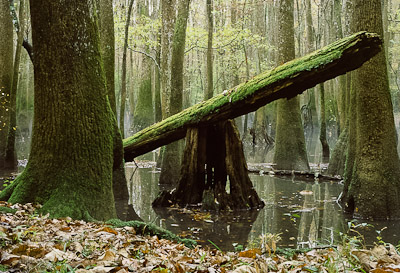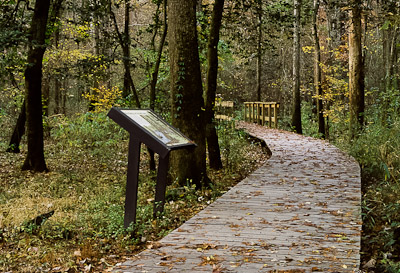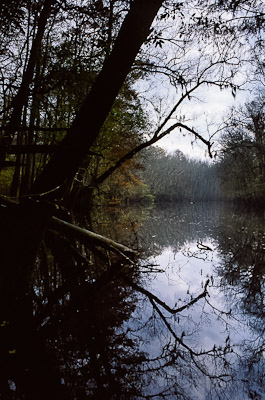The Primeval Congaree
[originally published Autumn 2000 Sandlapper]
I was thrilled to be sitting on the ground in soaked clothes as night fell in Congaree Swamp. Mist hung over streams as ancient cypress and tupelo towered against a brooding sky. Minutes earlier, I'd startled deer into a creek; they snorted and bounded deeper into the woods. When a huge bird flashed unidentified over my tent, it reminded me of a pterodactyl. Never mind that South Carolina's bustling capital was a half hour down the road — I was 200 million years from civilization.
Roughly half of Congaree Swamp National Monument, or 11,000 acres, has never been logged. That makes it the largest old-growth forest in the East and the largest old-growth floodplain in North America. Here are sweet gums, willow oaks, and southern red oaks as wide as a Chevy S-10. Water tupelos reach up to 10 stories, American elms and cherrybark oaks to 11 stories. Most interesting are the loblolly pines, which aren't expected in mature forests at all. Ancient fires, hurricanes, or diseases may have opened the canopy. Now, loblollies rise 160 feet from the forest floor, taller than dominant trees in the Amazonian rain forest.
 |
Fallen tree along the Kingsnake Trail. |
My three-day hike in late November paid off with cool weather, no bugs, and fine fall colors long after leaves had vanished around my home in western North Carolina. Crowds were light even on popular boardwalks by the visitor center. In the backcountry south of Cedar Creek, ten miles on three different trails revealed one tent and zero people. My experience reflected the Congaree's status as an underdog park that operates on a thin budget and offers little more than its natural wonders. With no museums, no driving tours, no shops, and no restaurants, the place is either a welcome refuge or a nightmare, depending on your expectations.
Personally, I loved strolling among old trees, mosses, and stream reflections that together reminded me of some grand Japanese garden. The swamp's eleven-page species list reveals ninety different trees and 230 herbaceous plants, all growing heartily in silt imported from upstream. Among them live 24 species of reptiles, 41 mammals, 52 fish, and 200 birds. The American Bird Conservancy lists the swamp as a Continentally Important Bird Area.
Perhaps less obvious is its role as a functioning freshwater wetland. The Congaree River's nasty habit of overflowing with Piedmont storm water ten times each year is mitigated by the swamp's free flood control. As biologist Charles H. Wharton wrote, "The river swamps ... may function in many ways: sponges for regulation of vital water cycle, giant kidneys for waste purification, convalescent wards for the esthetically ill, outdoor classrooms for school children and oxygen machines for air quality." If the Congaree was a man-made garden, it would be considered a marvel of aesthetics and engineering.
In reality, it has been allowed to survive only because most other options were thwarted. The myth that wetlands are wastelands prevailed through 1860 as settlers tried clearing the land for agriculture. All attempts were quickly abandoned, thanks to the Congaree's erratic tendency to go underwater for days at a time.
 |
Boardwalk at Weston Lake. |
The first real threat came in 1905, when Francis Beidler's Santee River Cypress Lumber Company bought the land. Areas near the river were logged, but the trees refused to dry, and green wood won't float to mills. Beidler chose to preserve the swamp's natural splendor after visiting the equally inspiring scenery of Yellowstone and Yosemite National Parks.
Fifty years later, higher timber prices heightened the temptation to log. Beidler's heirs cut up to 1,000 acres per year, pushing the Sierra Club and concerned locals into action. Congress finally formed Congaree Swamp National Monument in 1976, a good decision confirmed seven years later when the site was designated one of the world's 300 International Biosphere Reserves.
Still, today's swamp is a bit diminished from that of a dozen years ago. No activist group or congressional legislation could prevent non-selective logging by Hurricane Hugo in 1989, as trees that were protected by a timber baron for decades were wiped out by 80 mph winds in one night. Half the forest canopy and several national champion trees toppled, victims to shallow root systems that are fine for general bottomland survival but are highly susceptible to rare distress. The new openings do provide grazing land for wildlife and, more importantly, opportunities for loblolly pines to regenerate. In the darker woods of the recent past, loblolly seedlings couldn't gain a foothold.
Though safe for now, the Monument's political future carries no guarantees. According to The State newspaper, for example, the Congaree appeared on a list of expendables when federal budgets were snipped in 1994. The editorial explained: "A proposed review commission could cut the Park Service budget by cutting parks ... Despite National Geographic's salute to Congaree Swamp as 'nature at its best,' low-budget parks (which Congaree Swamp is) and parks that are primarily preserved open space (which Congaree Swamp is) are likely targets."
 |
Wise Lake. |
Yet, this Monument is far from being some remote, elitist wilderness. With a full pack I was amazed by how quickly I clicked off miles on easy trails. My parents, who hike frequently but avoid anything unpleasant, would enjoy the shorter loops that make perfect day hikes. Even our wheelchair-bound friend-of-the-family could go a mile deep on the wooden Low Boardwalk, which gives an up-close tour of wetland diversity on its way to Weston Lake. The 25 miles of excellent foot trails are complemented by an 18-mile canoe trail that follows Cedar Creek to the Congaree River.
Over 90,000 visitors found the Congaree's secluded main entrance in 1998, up 400% from ten years ago. The old stigma associated with wetlands may disappear as more people appreciate their role in flood control and clean water. General Francis "Swamp Fox" Marion of Revolutionary War fame was no naturalist, but he recognized the magnificence of his wetland hideouts. Even the most casual modern visitor must agree with one of Marion's most frequently-quoted journal entries: "I look at the venerable trees around me and I know that I must not dishonor them."
©Stephen Schoof